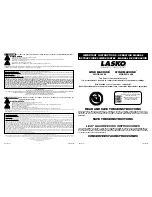
L&L VENT-SURE DOWNDRAFT KILN VENT INSTRUCTIONS
ventsure-instruct.pdf
REV: 8/1/2017
Page 6
©
2017
L&L Kiln Mfg, Inc. 505 Sharptown Rd, Swedesboro NJ 08085 856.294.0077 F:856.294.0070 [email protected] hotkilns.com
at the actual suction hole from the kiln and the pull around
the lid.
For Gross Adjustment:
Remember that the sliding adjuster is for fine adjustment.
Drilling or plugging the holes in the floor (and possibly
adding or plugging holes in the top) is how you would
dramatically change the amount of air vented.
VENTING CODES
OSHA has set standards for carbon monoxide exposure
of 35 ppm (parts per million) for long-term exposure and
200 PPM for short-term exposure. Independent testing
has shown that fumes near the kiln can exceed 200 PPM
near the kiln during the firing of greenware. This can
cause headaches, fatigue, sore throats and nausea. When
properly installed and operated, a downdraft vent removes
all harmful fumes and provides a safer working environment.
Most states and localities have set venting requirements
for firing kilns in public places. Your local and state health
board should have this information.
The Uniform Mechanical Code says that you must vent
ceramic kilns. It says that you can use a canopy-type
hood (and gives specific requirements for such use) or
that “listed exhaust blowers may be used when marked as
being suitable for the kiln and installed in accordance with
manufacturer’s instructions.”
Our Vent-Sure vent is listed to UL499 standards by MET
for L&L Kilns and is appropriate to meet this ventilation
requirement. L&L takes no responsibility for improperly
installed vents or kilns nor do we take responsibility for the
use of other vents with our kilns.
REGULAR MAINTENANCE
Occasionally check for leaks in the aluminum duct. Replace
if necessary. Check for corrosion especially if you are using
clay with a high content of sulfur, phosphorus or fluorine.
Check for wax or carbon build up if you are using a wax
resist process or a high carbon content clay.
We recommend unmounting the fan and blowing out the
squirrel cage with compressed air every two years or so
especially if you are in a very dusty or if you have it mounted
on the floor where it is more likely to pick up dust.
If the discharge duct of the vent is mounted pointing up you
may get water that condenses in the duct drop down and
rust out the motor. Taking it apart and spraying with WD-40
can restore the motor in some cases. We recommend
having a water trap in the bottom of a long vertical duct run
to drain off the water before it runs into the motor. This is not
a problem when the vent has been mounted horizontally.
INSTALLATION OF MULTIPLE VENTS
For more information see:
hotkilns.com/vent-doubler-system
VENT DOUBLER SYSTEM
This shows a photograph of the Vent Doubler System:
The Vent Doubler system includes a bracket for mounting the
vent motor on the floor or wall (as shown), an extra Bypass
Collection Box, an extra Flexible Aluminum Duct and a “T”
Connector with dampers. You can vent two 10 cubic kilns with
one Vent-Sure plus this Vent Doubler System.
CENTRAL VENT SYSTEMS
Multiple Vent-Sure systems may be installed individually,
or each system may be connected to a central duct. The
following information is provided to help the installer make
decisions concerning the size and length of the central duct.
CENTRAL DUCT SIZING
QTY OF SYSTEMS SIZE OF CENTRAL DUCT
1
4”
2
6”
3
8”
4
8”
5
10”
6
10”
EXTENDING DUCT LENGTH
The duct may be 60 feet in length, and include up to four
90° bends, without a significant drop in static air flow or
a reduction in kiln air pull. You may use any galvanized,
stainless or aluminum duct. The outlet duct size (after the
motor) is 4” diameter. The inlet duct (before the motor) is
3” diameter.





























